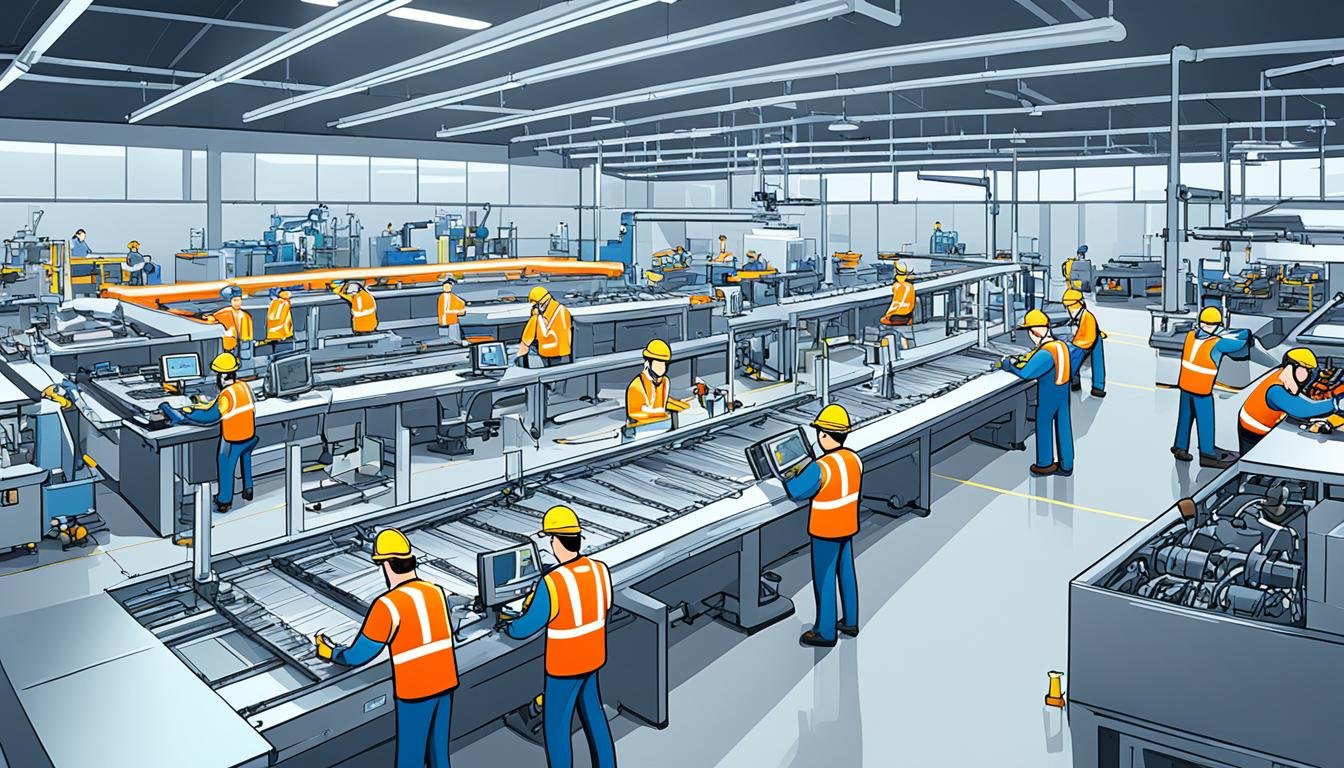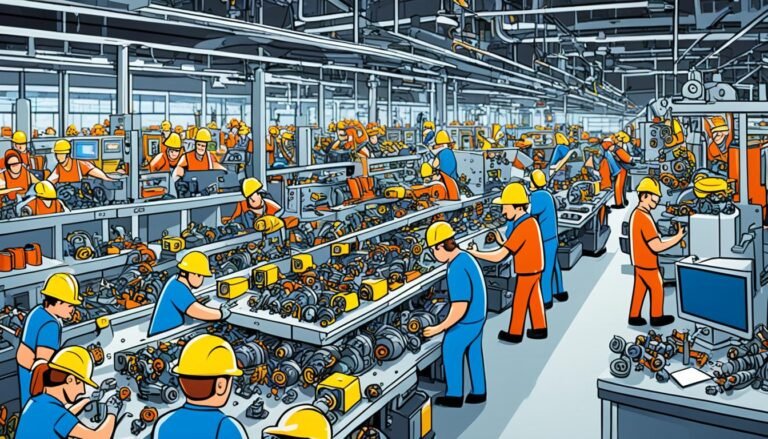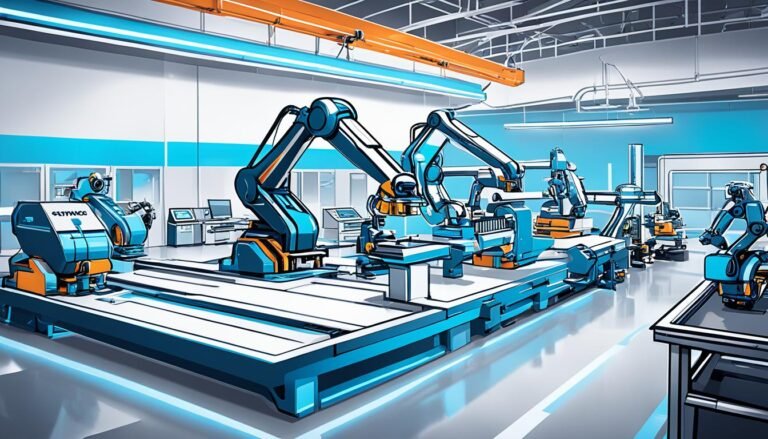Manufacturing Readiness Level: Production Preparedness
Did you know that nearly 70% of manufacturing projects face delays because they weren’t ready? This fact shows how vital it is to know and use Manufacturing Readiness Levels (MRLs). MRLs help avoid risks in production planning and ensure a smooth move from development to full production.
The Department of Defense sees the value in this and now requires MRL assessments in its Instruction 5000.02. This makes MRLs key for successful projects. An MRL check shows where you are in manufacturing, finds gaps, and helps plan for risk management and growth.
This article explores the key parts of MRLs. It talks about how they help improve project outcomes and give tips on planning and assessing readiness. Knowing about MRLs helps teams get ready for today’s complex manufacturing challenges, leading to better production readiness.
Key Takeaways
- Manufacturing Readiness Levels (MRLs) offer a standardized metric for evaluating manufacturing maturity.
- MRLs are crucial in reducing manufacturing risk and preventing costly delays.
- The Department of Defense requires MRL assessments to boost the success of acquisition programs.
- MRL assessments pinpoint current maturity levels and point out where improvements are needed.
- Good planning and readiness checks are key for a smooth move to full production.
- Using MRL evaluations leads to better risk management and planning for growth.
Understanding Manufacturing Readiness Levels (MRLs)
Manufacturing Readiness Levels, or MRLs, are numbers that check how ready a production process is for a new technology or system. They look at how ready the manufacturing is and spot potential problems. This helps everyone understand the production process better.
What are MRLs?
MRLs show how ready a technology is to be made on a large scale. They check if making the product is reliable, affordable, and follows the same steps every time. This makes sure new technologies can easily move from the lab to making lots of products without big problems.
MRLs vs TRLs
TRLs look at how well a technology works, while MRLs check how well it can be made. TRLs say if a tech does what it’s supposed to. MRLs make sure making the tech is efficient, affordable, and can be done on a big scale. Using both MRLs and TRLs gives a full picture of a technology’s use and how it can be made.
| Feature | MRLs | TRLs |
|---|---|---|
| Focus | Production Readiness | Technology Maturity |
| Assessment Aspects | Reproducibility, Costs, Standardization | Functionality, Performance |
| Purpose | Ensure Efficient Manufacturing Processes | Prove Technology Works as Intended |
| Usage | Industry, Production Planning | Research, Development |
The Importance of Production Preparedness
Getting ready for production is key to making products well, on time, and without going over budget. It means making sure every part of making the product is stable and ready. This makes moving from making prototypes to making lots of products smooth.
Using manufacturing readiness levels helps spot and fix problems early. This makes making the system better and getting good results when buying things easier.
Starting to get ready for production means using manufacturing readiness levels (MRLs). These levels help understand and manage the complex parts of making products. By using MRLs, companies can check how ready their production is and fix problems early. This helps make the system work well and leads to good results when buying things.
Checking and improving at every step of making a system better helps get ready for production. This way, companies can avoid surprises and make their production more efficient and effective.
Also, making production match MRLs leads to better results when buying things. As companies move up in manufacturing readiness levels, they can move from making prototypes to making lots of products. They know their processes meet industry standards and best practices.
In short, getting ready for production is very important. By using manufacturing readiness levels, companies can make their production smoother, support strong system development, and get good results when buying things. This approach helps deliver high-quality products to the market efficiently and effectively.
Assessing Manufacturing Readiness
Before we get into the details, let’s understand how we check if a production is ready. A deep look into manufacturing evaluation and MRL assessment makes sure processes are clear, risks are low, and everything is ready for production.
Key Metrics for Assessment
Manufacturing readiness depends on key metrics that show how well different parts of production are doing. These metrics are put into “threads”, each covering a key area for success:
- Design: Making sure the product design can be made and meets all requirements.
- Materials: Checking if the needed materials are reliable and available.
- Cost and Funding: Looking at budget and financial readiness.
- Process Capability: Seeing if manufacturing processes can make high-quality products consistently.
- Quality Management: Making sure quality controls work well.
Common Tools and Techniques
For a full MRL assessment, we use various tools and techniques. These help spot gaps and improve processes for better production readiness:
- Value Stream Mapping: A visual way to see the production process and find waste to make it more efficient.
- Self-Assessments: The production team checks themselves to see how ready they are and what needs work.
- Site Visits: Inspecting production sites to check if they meet standards and see how ready they are in real life.
MRL Definitions and Their Applications
Manufacturing Readiness Levels (MRLs) are steps to check how ready manufacturing processes are at different stages:
| MRL | Stage | Description |
|---|---|---|
| 1-3 | Material Solutions Analysis | Basic research and starting to develop the concept |
| 4-5 | Technology Development | Starting to develop the process and proving the concept |
| 6-7 | Technology Maturation and Risk Reduction | Improving the process more and lowering risks |
| 8-10 | Production and Deployment | Ready for full production and deployment |
Risk Management in Manufacturing
Risk management is key in manufacturing to make sure production grows and stays efficient. By spotting risks and fixing them, companies can overcome production hurdles. This makes the whole production process better.
Identifying Manufacturing Risks
First, we need to find out what risks are out there. These include things like special handling needs, not having enough materials, managing suppliers, and making sure workers can do their jobs. By knowing these risks, companies can get ready and fix problems before they happen.
Mitigation Strategies
To deal with these risks, it’s important to follow best practices in risk management. This means making detailed plans for different problems, checking on how we get our materials, and making sure suppliers are good quality. Also, having backup plans for unexpected issues is key to handling production challenges and growing production.
| Risk Category | Mitigation Strategy |
|---|---|
| Special Handling Requirements | Implement specialized training and safety protocols. |
| Material Availability | Diversify supplier base and maintain buffer stocks. |
| Supplier Management | Evaluate supplier performance regularly and establish strong partnerships. |
| Workforce Competencies | Invest in skill development and continuous training programs. |
Developing a Manufacturing Maturation Plan
Creating a manufacturing maturation plan is key to moving from development to steady production. This plan should cover important details like key performance areas, how things fit together, and what materials are used. By focusing on these, manufacturers can make their operations more efficient and improve production.
Steps in Creating a Plan
- Assess Current State: Start by looking at what you’re doing now, like your processes and tech. Know where you’re starting from.
- Define Goals: Set clear goals for improving production, focusing on costs, quality, and getting things delivered on time.
- Identify Key Performance Parameters: List the main things you need to measure to hit your goals.
- Create Actionable Tasks: Make a list of specific tasks that will help you reach your manufacturing goals.
- Assign Responsibilities: Put tasks on teams or people, making sure everyone knows what’s expected of them.
- Implement and Monitor: Carry out the plan and keep an eye on how it’s going. Make changes as needed to stay on course.
Best Practices for Implementation
- Detailed Cost Analysis: Do a deep dive into costs to find ways to save money without cutting quality.
- Identify Supply Chain Elements: Make sure you know and manage all important parts of your supply chain for better efficiency.
- Integrate Quality Management Systems: Put in place strong quality management systems to keep standards high and reduce waste.
Following these best practices in your manufacturing maturation plan will help you move smoothly towards your goals of cost savings and efficiency.
Technology Maturation and Process Capability
Technology maturation and process capability are key in moving from prototypes to large-scale production. They make sure a system or component can be made reliably on a big scale. This means improving manufacturing methods, checking material properties, and making sure designs work well in production.
The Role of Technology Maturation
Technology maturation closes the gap from prototypes to full-scale making. It involves thorough testing to make sure materials and processes are ready for mass production. Companies must ensure each part of the technology works well in real situations. By improving processes and materials, companies can cut costs and meet lean manufacturing goals.
Ensuring Process Capability
Process capability is vital for being ready to manufacture. It means setting up processes that make parts within the allowed limits, ensuring quality. Using statistical methods helps keep processes stable for better system performance. Following lean manufacturing helps companies make things more efficiently, reduce waste, and improve product quality.
Technology maturation and process capability work together for manufacturing success. They help products meet design specs and keep up performance and quality. This leads to happier customers and a competitive edge in the market.







